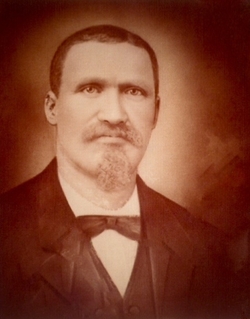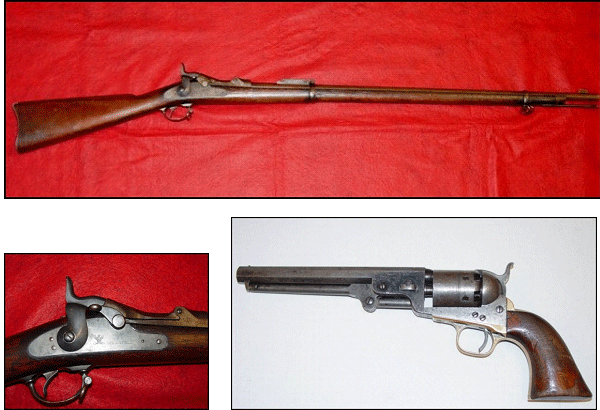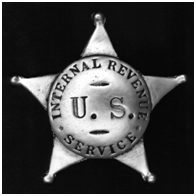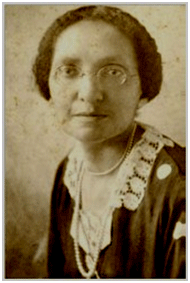A Buried Injustice: Deputy Collector William Henderson Foote, ATF's Legacy Treasury Agent, Killed in the Line of Duty, December 29, 1883, Yazoo City, Mississippi
Recovery of a Fallen Hero

ATF has recently discovered that during the mid to late 1800s, as many as 40 deputy collectors were killed in the line of duty while serving with the Department of Treasury's Bureau of Internal Revenue (BIR), one of ATF's legacy agencies. While most were killed by well-armed moonshiners, one was not.
Deputy Collector William Henderson Foote, an African American, was lynched by a mob on December 29, 1883, in Yazoo City, Mississippi. Four days earlier, Foote had intervened to save a fellow Yazooan from a lynching which resulted in three white men killed, and Foote and 10 other African American men jailed and subsequently charged in their deaths. The Yazooan whom Foote tried to prevent from being lynched was pursued by a posse and gunned down.
For over a week, newspapers from across the country reported on the Terrible Tragedy in Yazoo, yet the BIR's official annual report, the venue for reporting line of duty deaths, made no mention of its federal officer's death. One hundred and twenty eight years after his death, archived newspaper articles, scholarly articles, books, government reports, and genealogical databases, along with Foote family history passed down through 4 generations have all come together to tell the story of Deputy Collector Foote, killed in the line of duty, defending the rule of law in protection of a citizen's basic civil rights.
ATF's Historical Deputy Collector Era
ATF's Deputy Collector Era lasted from 1862 until 1919 and was named for the deputy collectors or "Revenuers," as they were known by the public, who enforced the nation's liquor revenue laws. On July 1, 1862, the U.S. Congress created the ATF. This Treasury Bureau was staffed not only with special agents, collectors, deputy collectors, and assessors concerned primarily with enforcement of liquor tax laws and the collection of liquor taxes, but also with inspectors, gaugers and storekeepers who regulated the production of alcohol at distilleries and breweries.
ATF, far from being an integrated bureau, employed a significant number of African Americans, though they had to contend with racial animosity within the ranks, as well as racial violence in the communities to which they were assigned.
In an 1882 report, General Green B. Raum, ATF Commissioner, related the evidence from an investigation into the violence being faced across the country by his force of Revenuers and other federal officials such as the U.S. Marshals and U.S. Army soldiers, including government informants. The violence was so rampant that Raum found it necessary to authorize collectors to employ a temporary force to aid the regular deputies in policing their divisions and seizing illicit distilleries, and to issue many collectors with guns from the Ordinance Department of the government to enable them to arm their deputies for self-defense.
Foote: The Early Years
The Foote family followed a general migration pattern of most early settlers into Mississippi. William's father hailed from Virginia, his mother from Alabama, and William was born June 27, 1843, in Vicksburg, Mississippi. In the 1850 Vicksburg census, the Foote family lived as part of the city's free Black community; his father, David, was a barber, and his mother Millie a homemaker. They resided in the home of William's paternal grandparents, Billie and Kitty Foote, he a drayman and she a well-known midwife. Kitty Foote was considered the wealthiest free Black woman in Vicksburg. In the 1860 Vicksburg federal census, her total wealth is listed as $1,700, the equivalent of approximately $40,000 today.
At the start of the Civil War the following year, William Foote, at 19, entered the military; however, on which side he served remains unsettled. Despite the lore suggesting that it was the Confederate Army, Foote's own testimony provides the biggest clue. In Jackson, Mississippi, in the summer of 1876, as part of a Congressional inquiry into the violence of the Mississippi 1875 elections, Foote was among various officials and citizens who testified. During his official testimony, Foote gave his background, stating, "I was away from there [Vicksburg] during the war." And when asked, "Where were you during the war?" Foote responded, "In Virginia, in the army."
With the end of the Civil War, the promise of a new path for African Americans was buttressed by the nation's first civil rights legislation of 1866. Foote is thought to have attended Oberlin College in Ohio, and around 1867, he settled down in Yazoo City. Along the way, he married a native Mississippian named Mattie, who bore him three children.
The Courageous Yazooan
In 1869 during the period of Reconstruction, the military governor of Mississippi, General Adelbert Ames, charged with filling numerous civil positions with qualified individuals, appointed Foote as the Constable of Yazoo City. A citation later noted he carried out his duties with courage and discretion.
By the election of November 1869, the first in which Yazooans were able to fully participate, Foote ran for office on the Republican Party's ticket. Although a newcomer to politics and despite the very violent and hostile crowds through which he navigated, he never flinched when campaigning. He always appeared fully composed and greeted friends with cheer. The local Democratic Party pulled out all stops to win the election when they handed out pork and flour, and threw clothes and sometimes even money into the crowd to sway the African American vote. Foote rigorously campaigned, moving rapidly from one town to another, attempting to garner African American votes, most of whom were in the Republican fold.
In one remarkable and documented event, Foote mounted a horse and rode to a site where 400 voters had been prevented from reaching the polling booths to vote. The culprit turned out to be Henry Dixon and his gang of ruffians who were well known throughout the town as troublesome instigators. Upon Foote's arrival, Dixon threatened to kill Foote if he interfered. Foote rallied the crowd with words on the importance of the new state constitution which granted legitimacy to their freedom and to their right to vote. Foote then fearlessly led the line of voters into town to vote, unobstructed by any further harassment.
White voters were so incensed by Foote's political activism that they massed and confronted Foote at a gathering of Freedmen. A potential threat of extreme violence developed between the two sides. Foote and his supporters would neither stand down, nor stop advocating for basic civil rights, by now guaranteed in two of the three Reconstruction Amendments: the 13th ended slavery, and the 14th defined citizenship and guaranteed due process of law and equal protection. The 15th, which would be passed the following year, granted voting rights regardless of race, color, or previous condition of servitude. As the men converged, both groups drew pistols ready for the ball to commence, the era's reference to the start of violence. Only with the arrival and intervention of Charles Morgan, Sheriff Albert Morgan's brother, did the developing standoff de-escalate with both groups laying down their guns. The election continued and the Republicans were voted into office.
Foote was voted into the Mississippi Legislature representing Yazoo County from 1870 to 1871, becoming one of a number of African Americans achieving political power throughout the South. Simultaneously, he held the position of town marshal and eventually became the town's circuit clerk. Foote's role in politics and law enforcement was aided with the passage of the Force Acts of 1870 and 1871 to enforce and protect the voting rights of African Americans, along with the Civil Rights Act of 1871, informally known as the Ku Klux Klan Act, which attempted to limit the Klan's activities. Still, Foote often found himself mixed up in the general violence that permeated the town's politics as white resistance to the enfranchisement of African Americans deepened.
Politics
In 1873, Foote advocated for a political party formed by Southerners and African Americans to the complete exclusion of Northerners. As such, he campaigned for a Democrat named Hilliard who was running for re-election as sheriff. Hilliard was soundly beaten in the November election, but refused to vacate the Sheriff's Office, preventing a seamless transition for the newly elected sheriff Albert Morgan, a Republican.
This stand-off continued until January 1874, when the newspaper reported that the ball had opened, referring to the violent event that finally settled the transfer of the office. While Hilliard was away, Morgan's deputies physically took over and secured the sheriff's premises, and then waited to see how Hilliard would react to the forcible takeover.
Hilliard fumed when he heard what had happened, and along with his supporters, one of whom was Foote, set off to take back the Sheriff's Office. Upon arrival, Hilliard and his friends broke the door down, and when Hilliard fired a shot into the office, a shot from inside was fired back, and Hilliard was killed. Sheriff Albert Morgan moved into his new office and braced himself to handle the mounting political and racial strife between Democrats and Republicans, and whites and African Americans in 1874 Yazoo City, Mississippi.

This Navy Colt .36 pistol (bottom right) was the gun of choice for moonshiners and ruffians warring with Deputy Collectors. By the late 1870s, the moonshiners had become so violent toward alcohol tax enforcers that the U.S. Government Ordnance Department issued Springfield breech loading single shot rifles (top and bottom left) to Collectors for distribution among their Deputy Collectors for enforcement operations. These rifles were also known as Trapdoor Springfields. The pictured rifle and pistol are part of the ATF Firearm Reference Library. (Photos by Ron Davis, Equipment Specialist, ATF's Firearms Technology Branch)
On September 2, 1875, Foote was shot while attending a speech given by Sheriff Albert Morgan. Democratic instigators provoked the crowd and a melee broke out. The Yazoo Banner blared: "A Riot in Yazoo City: The Natural Result of Radical Teaching." Nearly a week later, The Yazoo City Democrat reported that W.H. Foote was still suffering from his wound.
By 1876, Foote served as a city or county Deputy Delinquent Tax Collector, and in 1877, he ran for sheriff of Yazoo City, losing to the Democratic candidate, though he rigorously campaigned as an Independent candidate.
On Duty in Yazoo City
In 1880, James Hill, an African American BIR Collector headquartered in Jackson, Mississippi, appointed Foote to serve as a deputy collector in Yazoo City. It was standard practice at the time for all BIR collectors to hire their own deputy collectors. By then, Foote was well known in Yazoo City for his professional demeanor and his steadfastness in standing up against the persistent and growing discrimination targeted against the African American community.
Yazoo City was a river town, and the Yazoo River was a key mode of transportation used by the area's farmers to ship their cotton to market in Memphis, Vicksburg, and New Orleans both before and after the Civil War. On the return trip, the steamboats brought Yazoo City's merchants and farmers various goods, including liquor. Deputy Collector Foote's duties involved collecting the revenue from liquor wholesalers and retailers.

The 1880 census record indicating William Foote's occupation as a Revenue Collector.
By the 1870s, there were about 41 liquor stores and saloons in Yazoo City, a town of fewer than 2,500 people. Most businesses had no problems providing a steady supply of liquor for their customers. In 1877, it cost one dollar to ship a barrel of whiskey from Vicksburg to Yazoo City. After the war, steamers, working strictly as trade boats on the Yazoo River, carried kegs of beer along with other necessary provisions and merchandise.
The bigger steamboats, known as palace steamers or showboats, traversed the rivers of the Delta, including the Mississippi, touting bars stocked with assorted alcohol, including wine. It was a common business practice for steamboat owners to sell liquor through onboard barroom concessions. The Kate Adams, one of the most famous steamboats in the Delta, had liquor, gambling, bands and dancing. The Yazoo River boats, steamboats of a smaller tonnage, may not always have had a bar, but they almost always had an abundant amount of whiskey on hand for the crew and passengers.
Racial Violence
By 1883, with reconstruction having ended six years earlier, the South's period of disenfranchisement of African Americans was well under way. Racial tensions continued to pit citizen against citizen, tearing apart the communities of the South. Yazoo City was no exception. Foote's reputation as a Revenuer and community leader would be called upon one last time.
John T. Posey was a merchant who ran a boot and shoe store in Yazoo City and was known about town as a high-toned honorable gentleman. His father was famed Confederate General Carnot Posey. On December 24, 1883, John Posey rode into town looking for an African American man named John James, whom he intended to whip. Accounts of the time speculate on possible reasons as to what John James may have done to cause John Posey to feel the need to correct a perceived slight: a contest over the smiles of a belle at a Yazoo City African American ball, a verbal insult, or perhaps, even an unsettled barroom brawl. The only thing known for certain is that on Christmas Eve, John Posey had decided to seek retribution.
The term whipping is a euphemism for a beating, and along with burning, shooting, and hanging, are all various forms of lynching, the most common act of violence used against African Americans. Since the end of the Civil War, government officials such as Freedmen Bureau agents, U.S. Army officers and soldiers, U.S. Marshals, U.S. Secret Service operatives, Department of Justice examiners and U.S. District Attorneys were all charged to enforce civil rights laws by arresting and prosecuting perpetrators of violence against African Americans. Despite limited success against the Ku Klux Klan, by the end of reconstruction, civil rights enforcement had all but ended. Still, in 1883, a whipping for an African American, at minimum, constituted an aggravated assault; at worst, it was murder.
Shielding a Man From a Whipping
Foote and his family were attending Christmas Eve church services when a townsperson interrupted to warn Foote that John Posey had ridden into town looking to whip John James. Like so many times before, Foote didn't hesitate to respond to a threat against an African American in Yazoo City. With total disregard for his own life but carrying the inherent responsibility of someone who has been known as a man of the law, he left his family and congregation and proceeded into town to intervene.
Upon arriving at the scene, Deputy Collector Foote placed himself between John James and the whipping party which included John Posey, his brother Carnot Posey, and a man named Jasper Nichols. All were armed, and despite Revenuer Foote's protests, John Posey made it clear that he was determined to avenge his honor. By then, a group of African Americans had gathered around and behind Foote in a show of solidarity.
It is impossible to say with certainty what happened next, but once the gunfire ended and the smoke cleared three white men were dead: the two Posey brothers and Jasper Nichols. Foote suffered a head injury from a blow by either a stick or the end of a revolver. John James escaped from town only to be gunned down later by a posse attempting to arrest him.
Foote and ten other African Americans were arrested and placed in the Yazoo City jail. A coroner's jury indicted Foote and three others as principles along with seven others as accessories.
Newspapers reported accounts of what happened. On January 2, 1884, The Chicago Daily Tribune printed, "it is evident that the Poseys and their friends were the aggressors and brought about their own destruction." On December 27, 1883, The Yazoo Sentinel reported an opposing sentiment: "One of the most cold-blooded unmitigated, premeditated pieces of assassination that ever occurred by which three men in the prime and vigor of young manhood were shot down like dogs."
The Lynch Mob: Give Us That Deputy Collector Foote

On Christmas Day, Yazoo's town leaders gathered to discuss the situation. Tensions ran high and soon the talk turned to whether the law of self-preservation was higher than the rule of law. One point of view coalesced into a general consensus that, unless some example was made of the guilty parties, there would be deadly consequences to their community. The direction of their evolving sentiment did not bode well for the jailed African Americans. Meanwhile, armed men began gathering in town, some who had heard of the incident and had traveled from other parts of the county to stake a claim in the activity.
Four nights later on December 29, Deputy Collector Foote awaited trial inside the Yazoo City jail along with the ten other men. In town, a well-armed mob was growing in size and ferocity. As the mob of more than 200 people began moving towards the jail, they encountered one of two persons who would appeal for calm and attempt to derail any extrajudicial punishment. Father Wise, a Catholic priest, who at the behest of the mother of the deceased Posey brothers, made an appearance on Main Street and earnestly talked to some of the mob's leaders pleading to let the law have its course.
Two hours passed before the momentum of the mob, once again, pushed forward to the jail, and broke through the gate of the fence surrounding the jail. Conspicuously, the sheriff was nowhere to be seen. In his stead, an African American jailer had been left with the keys to the cells.
As the mob entered the jailhouse, they went looking for Foote and the three others indicted as the principal trigger men. It was then that James A. Barksdale, a member of the State Legislature, entered the jail, and pleaded with the mob. He invoked the name of ex-Sheriff Taylor, an influential and revered man in Yazoo County, hoping to dissuade the mob from taking justice into their own hands. Barksdale then asked them to consider the pleas of Mrs. Posey, who asked that there be no further violence.
Lynchings are horrific and this one was no different. The mob clamored for Foote, yelling, "Give us that Deputy Collector Foote." Though outnumbered, Foote fought the mob with relentless strength and determination, but was felled by several gunshots to the head, which rendered him unrecognizable. Just as tragically, the other three men were hanged.
Honored
Deputy Collector Foote's body was recovered, and the funeral service was held at the Bethel African Methodist Episcopal Church (AME) in Vicksburg. His final resting place is Cedar Hill Cemetery, also in Vicksburg. Deputy Collector Foote was survived by his wife, Mattie J. Foote, and their children, sons Willie and Joseph and daughter Mattie.
On January 2, 1884, The Chicago Daily Tribune concluded that with Foote and the other three now dead, there was no chance for the truth ever to be known, the sad consequence of any extrajudicial killing. It's tragic that the nation's earliest civil rights laws were not fully enforced, leaving the African American community vulnerable. However, the protection of those civil rights, beyond the responsibility of revenue collectors, was something Foote had honorably and courageously defended his entire life.

In July of 2011, at the National Organization of Black Law Enforcement Executives (NOBLE) conference held in Lexington, Kentucky, Dr. Bettye Gardner, great niece of William Foote, posthumously accepted the Gold Star Medal awarded to Deputy Collector Foote by ATF's then Acting Director Kenneth Melson.
During Police Week in 2012, Foote's name was unveiled on the ATF Memorial Wall located at the ATF National Headquarters Building, and the National Law Enforcement Officers Memorial (NLEOM), both in Washington, D.C. In attendance was Foote's great-granddaughter, Mattie Patricia Nolcox, and her family which includes a great-great-great-granddaughter. Dr. Bettye Gardner and her extended family and friends were also present. At last, Foote's life was reconciled with the honor that is afforded to all fallen law enforcement officers.
Sources and Acknowledgements
Deputy Collectors are believed to be direct forerunners of today's special agents because their duties were to enforce federal tax laws. They collected tax from licensed wholesale and retail distilleries, seized illicit distilleries and moonshine products and arrested and prosecuted tax violators. In 1934, after Prohibition was repealed, agents resumed the responsibilities of pre-1920 deputy collectors under the title of investigators and special agents. After 1879, deputy collectors were armed by collectors, and there is evidence that they carried badges. Two deputy collectors from the same era with the same job series and responsibilities are already honored on the NLEOM walls as fallen law enforcement officers.
Special thanks to the Triangle Cultural Center in Yazoo City, Mississippi, which was instrumental in providing a copy of a key article, entitled "Foote and Yazoo Politics 1869 to 1883," written by Dr. Bettye Gardner, published in Southern Studies, An Interdisciplinary Journal of the South, Volume XXI, Number 4, Winter, 1982. Dr. Gardner, an accomplished and well-respected African American historian, professor and mentor, also happens to be the great-niece of William H. Foote.
A major resource for information on Foote was written by former Yazoo County Sheriff Albert Morgan in his book, Yazoo or, On the Picket Line of Freedom in the South.
Also, thanks to ATF Special Agent Robert J. Haar of Jackson, Mississippi, who helped track down documentation on Deputy Collector Foote, and to Carla E. Young, senior counsel in ATF's Field Operations directorate, who helped clarify the rule of law in the 1800s.


